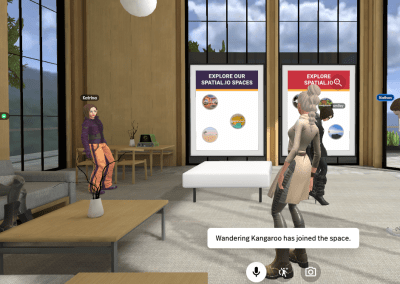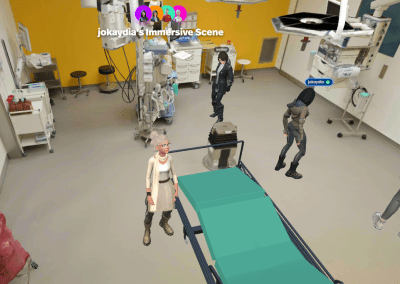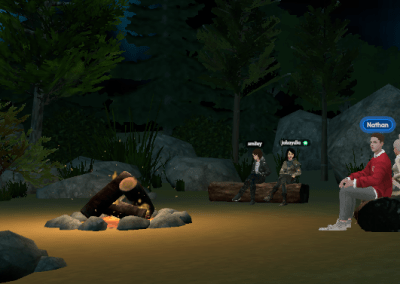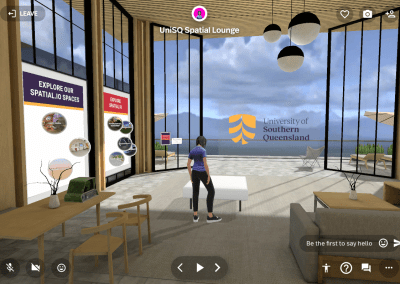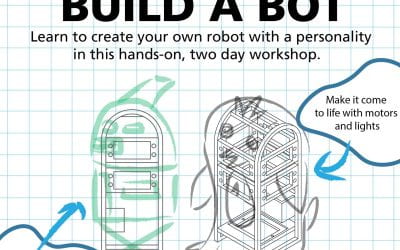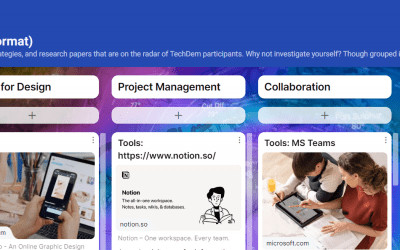
Special Interest Group – Virtual Immersive Environments
Technology Demonstrators > Special Interest Groups > Virtual Immersive Environments SIG
About the Virtual Immersive Environments SIG
The Virtual Immersive Environments SIG will be engaging members to think differently about learning environments through a systematic approach to the best practice use of virtual immersive environments. In our context we will investigate a range of VIEs to design bespoke experiences for each context and educational challenge. This may include an experience in which the user
a) wears a headset or
b) navigates an avatar in a digital space (computer, tablet, phone).
They may be pre-made spaces or ones in which we create content and experiences.
Providing VIEs for our students has the capacity to:
- bring all students (online and on-campus) in to the one space to participate in the same activities;
- design and build stories for presentation and collaboration;
- experience environments similar to the ‘real world’ in relation to physics, topography, spatially and interact with objects as if in the ‘real world’;
- undertake experiments that are otherwise too expensive or risky to do in the ‘real world’
VIEs provide opportunities to:
- create environments leading to deeper understanding of concepts particularly useful to students of architecture, design and education.
- experience places that cannot otherwise be visited – Space, remote locations, fantastical realities
- develop a deeper understanding of how to undertake clinical work particularly useful for nursing, health and education
- interact with people and places in different cultural settings and languages
Spatial Resources
Spatial Room URLs
What’s New
The last SIG meeting was on Wednesday April 12 at 1pm in the Ampitheatre. You are invited to go in at anytime.
The next SIG meeting – TBC
Resources
Dalgarno, B., & Lee, M. J. W. (2010). What are the learning affordances of 3-D virtual environments? British Journal of Educational Technology, 41(1), 10-32. https://doi.org/10.1111/j.1467-8535.2009.01038.x
Dalgarno, B., Gregory, S., Carlson, L., Lee, M. J. W., & Tynan, B. (2013). A systematic review and environmental analysis of the use of 3D immersive virtual worlds in Australian and New Zealand higher education institutions. Final report 2013 (dehub Innovation in distance education) http://dehub.edu.au/publications/books/
Dede, C. (2009). Immersive interfaces for engagement and learning. Science, 323(5910), 66-69. https://www.science.org/doi/pdf/10.1126/science.1167311
Jacka, L. (2015). Virtual worlds in pre-service teacher education: the introduction of virtual worlds in pre-service teacher education to foster innovative teaching-learning processes [Southern Cross University]. https://researchportal.scu.edu.au/discovery/fulldisplay/alma991012821255202368/61SCU_INST:ResearchRepositor
McGee, B. L., & Jacka, L. (2021). Virtual reality in education. Broken promises or new hope? In Gregory, S., Warburton, S., & Schier, M.(Eds.),Back to the Future –ASCILITE ‘21. Proceedings ASCILITE 2021 in Armidale (pp. 74–80). https://doi.org/10.14742/ascilite2021.0111
Savin-Baden, M., Gourlay, L., Tombs, C., Steils, N., Tombs, G., & Mawer, M. (2010). Situating pedagogies, positions and practices in immersive virtual worlds. Educational Research, 52(2), 123 – 133. http://www.informaworld.com/10.1080/00131881.2010.482732
Warburton, S. (2009). Second Life in higher education: Assessing the potential for and the barriers to deploying virtual worlds in learning and teaching. British Journal of Educational Technology, 40(3), 414-426. https://doi.org/10.1111/j.1467-8535.2009.00952.x
Read the Blog
Visit our conversations page to read about this topic and more.
PowerPoint as an eBook
eBooks and eWorkbooks are used in many different contexts.
Build a Bot Workshop Showcase
This video is a showcase of the recent ‘Build a Bot’ robotics class in the UniSQ Library Makerspace.
What is digital literacy and why does it matter?
The concept of digital literacy is a long-debated subject (Bawden, 2008). The concept of digital literacy arose in the late 1990’s as the digital age began to emerge from its infancy.
Microsoft SIG Meeting – August 2022
A recording of the August Microsoft for Teaching SIG meeting.
Tools Supporting Student Engagement
The recent Student Engagement SIG meeting focussed on tools that support student engagement.
I’m not IT… and other urban myths
Recently I was at a meeting with a group of experienced educators looking at ways to engage students with a co-curricula project, when I heard the refrain “I’m not IT” used as a reason not to create an equivalent experience for online students.

